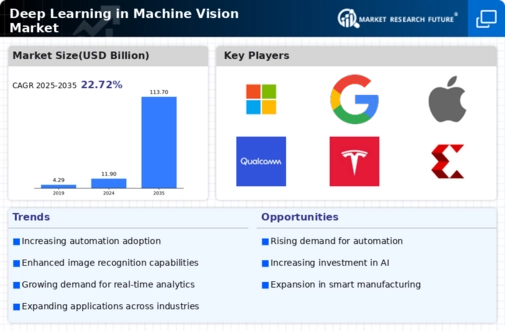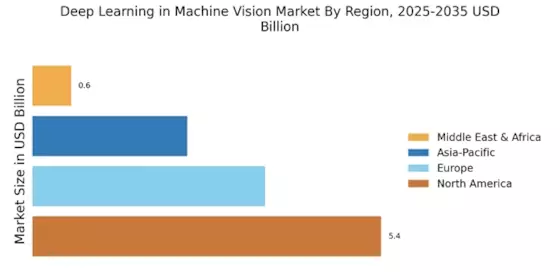Rising Demand for Automation
The Deep Learning in Machine Vision Market is experiencing a notable surge in demand for automation across various sectors. Industries such as manufacturing, logistics, and agriculture are increasingly adopting automated systems to enhance efficiency and reduce operational costs. According to recent data, the automation market is projected to grow at a compound annual growth rate of approximately 10% over the next five years. This trend is likely to drive the integration of deep learning technologies in machine vision systems, enabling real-time data processing and decision-making. As organizations seek to optimize their operations, the reliance on advanced machine vision solutions powered by deep learning is expected to escalate, thereby propelling market growth.
Advancements in AI Technologies
The Deep Learning in Machine Vision Market is significantly influenced by rapid advancements in artificial intelligence technologies. Innovations in neural networks, particularly convolutional neural networks (CNNs), have enhanced the capabilities of machine vision systems. These advancements allow for improved image recognition, object detection, and classification tasks. The market for AI in machine vision is anticipated to reach a valuation of over 20 billion by 2026, indicating a robust growth trajectory. As AI technologies continue to evolve, they are likely to provide more sophisticated tools for analyzing visual data, thereby expanding the applications of deep learning in various industries.
Growing Need for Quality Control
Quality control remains a critical aspect of production processes, and the Deep Learning in Machine Vision Market is poised to address this need effectively. With increasing consumer expectations for product quality, manufacturers are turning to machine vision systems to ensure compliance with standards. Deep learning algorithms can analyze images for defects and inconsistencies at a speed and accuracy that surpasses human capabilities. The market for quality control solutions utilizing machine vision is projected to grow significantly, with estimates suggesting a rise to 15 billion by 2025. This trend underscores the importance of deep learning technologies in enhancing quality assurance processes across multiple sectors.
Expansion of Smart Cities Initiatives
The concept of smart cities is gaining traction, and the Deep Learning in Machine Vision Market is integral to this development. As urban areas seek to improve infrastructure and public services, machine vision systems powered by deep learning are being deployed for traffic management, surveillance, and public safety. The integration of these technologies can lead to more efficient urban planning and resource allocation. Reports indicate that investments in smart city projects are expected to exceed 1 trillion by 2025, creating substantial opportunities for machine vision solutions. This expansion is likely to drive the adoption of deep learning technologies in urban environments.
Increased Investment in Research and Development
Investment in research and development is a key driver for the Deep Learning in Machine Vision Market. Companies are allocating significant resources to innovate and enhance machine vision technologies, focusing on improving accuracy, speed, and adaptability. This trend is evident in the growing number of patents filed in the field of deep learning and machine vision, which has increased by over 30% in recent years. As organizations strive to maintain a competitive edge, the emphasis on R&D is expected to foster breakthroughs that will further propel the market. Enhanced capabilities resulting from these investments will likely lead to broader applications and increased market penetration.


















Leave a Comment